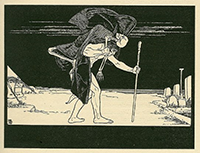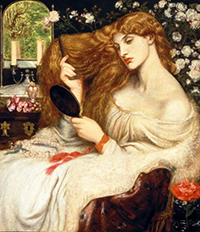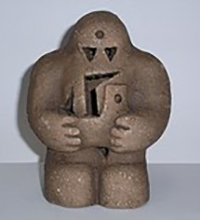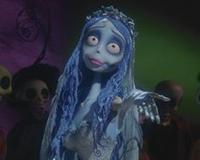
Even though Halloween began as a pagan holiday, it now brings spooky fun to children and adults of all backgrounds, including many Jews who view it as a secular holiday. As Halloween approaches, I enjoy dusting off my favorite stories of goblins, ghouls, and things that go bump in the night. This year, since I also have a soft spot for folk tales and mythology, I began exploring supernatural entities that can trace their origins back to Jewish folklore and was fascinated by what (or should I say who) I discovered. Unless you took a course in feminist midrash or have dug deep into Yiddish literature, you likely haven't come across these mystical characters, either.
So, light your favorite fall-scented candles, brew yourself a cup of tea, curl up with your favorite blanket, and join me as we learn about some of Judaism's spookiest figures.
1. Dybbuk
A dybbuk is not a demon. At least, it is not just a demon. Dybbuks are created when someone dies, but their soul doesn't move to the next stage of its journey. The soul can then be found by a demon who guides it to a living person, providing the soul with a body to inhabit and the demon with a person to possess.
According to kabbalistic literature, a case of dybbuk possession could only be cured through an exorcism performed in a synagogue by a rabbi in the presence of 10 men who had fasted and immersed in a . The exorcism involved the rabbi addressing the dybbuk, listing the offences the deceased soul may have committed in life, cursing the dybbuk, and pronouncing seven different iterations of God's name. Once the dybbuk was expelled, it was only to leave the body in the space between the nail and nail bed of the big toe. If it were to leave by any other route, the possessed person could be permanently harmed.
2. Lilith
Few figures in Jewish folklore have more diverse reputations than Lilith. According to legend, Lilith was Adam's first wife. She strove for equality with Adam, citing the fact that they were both made from the earth. Adam disagreed, stating that he was to be dominant in the relationship. Lilith responded by leaving Eden, sprouting wings and flying off. When God sent angels to retrieve her, she refused to return and was instead turned into a demon.
Since the first century CE, Lilith has been considered the ultimate femme fatale: seducing men, killing small children, and threatening the wellbeing of pregnant women. There have been archaeological finds of talismans and amulets made to guard people from Lilith's powers. Some parents still hang red ribbons on a newborn's crib to ward off Lilith. Even the word "lullaby" can be traced to the phrase "Lilith-abi," meaning "Lilith, begone."
In the modern era, Lilith's image has begun to be rehabilitated. While some still perceive her as evil, others see her as a symbol of women's empowerment. There is even a Jewish feminist journal named after her. No longer a one-dimensional figure, Lilith has become a complex character that illustrates how Jewish perceptions of independent women have evolved.
3. The Golem
The principles of golem creation date back to the time of the Talmud, which tells the story of some rabbis who were on a journey and became hungry. They created a calf from clay (as one does), brought it to life, and ate it for dinner. Yum?
The most famous golem tale is over 500 years old. The Golem of Prague was created by Rabbi Judah Loew to protect the Jews of Prague during a time of virulent antisemitism. The golem would protect the Jewish population from those who wanted to harm them. However, over time, the golem became too strong and, some say, violent. Others say that the golem was a gentle soul who only became violent when its protection was needed.
Either way, after being promised that the attacks on Jews would end, Rabbi Loew followed the same ritual that brought the golem to life, but in reverse. This put the golem in a state of hibernation. It is alleged that the golem is still housed in the Altneushul in Prague, ready to be awakened when it is needed again.
4. The Corpse Bride (yes, that Corpse Bride)
Finally, rounding out our list of eerie folk characters is Emily from Tim Burton's 2005 film. Okay, okay. Emily herself isn't a figure from the Talmud or kabbalistic literature, but the story that she is part of can be traced back to Jewish folklore.
There is a Jewish tale that seems to have inspired the storyline of the movie, dating from 16th century Palestine.
The story is entitled "The Finger" and closely mirrors the premise of the movie: a young man is walking in the woods the night before his wedding. When he sees a finger sticking out of the ground, the groom-to-be places a ring on it and says the marriage vows three times, causing the corpse to return to life and chase him back into the city. The next day, just as the rabbi is preparing to lead the groom and his betrothed through their vows, the corpse interrupts the wedding and declares that the young man cannot be married, as he is already married…to her. The rabbi convenes a , and, after much deliberation, they determine that the young man is not married to the corpse for three reasons. First, he was already betrothed when he said the wedding vows to the corpse. Second, he had made the vows as a joke, not with the sincere intent of marrying the corpse. Finally, and perhaps most reminiscent of the movie, the living cannot marry the dead, as death has already parted them.
However you choose to enjoy the autumn season, remember to check your , say the before you go to sleep, sing the children in your life a lullaby to keep them safe, and if you happen to have a ring on you, don't propose marriage to a dead hand or a tree branch! You may get more trouble than you expect.
Related Posts

Eight Unforgettable Jewish Oscar-Winning Movies

Eight Jewish Movies to Cuddle Up to in the Winter






